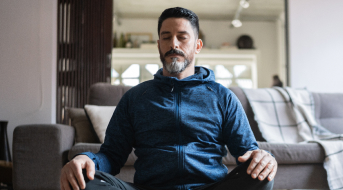Dr. Jill Rau explains low cerebrospinal fluid pressure headache, its treatment and how to help your doctor get a correct diagnosis
Following a recent surgery or injury, you’ve noticed that you have a headache that won’t go away. It feels better when you lie down, but it hurts you when you’re up and about. It causes things like dizziness and memory fog, and you’re not sure what the exact problem is. One possibility is low cerebrospinal fluid pressure headache (low CSF pressure headache).
Low CSF pressure headache is uncommon and might be overlooked by doctors if a patient doesn’t know how to properly explain what they’re experiencing. But understanding what to look for and how these headaches happen may help you point out the right clues for healthcare providers to put you on the right treatment plan.
We recently spoke with Dr. Jill Rau, a neurologist and headache fellow at Mayo Clinic in Arizona about low CSF pressure headache. She touched on what they are, how they happen and what your doctor is looking for when they suspect low-pressure headache is occurring.
What is Low CSF Pressure Headache?
Headaches with a known cause are referred to as secondary headache disorders. Unlike migraine, Dr. Rau says, we know exactly what causes low CSF pressure headache, meaning it falls under this category.
According to Dr. Rau, low CSF pressure headache is a headache that occurs from a reduction in the volume or pressure of the fluid that surrounds your brain and spinal cord. She explains that CSF is contained in a sac that acts as a cushion for the brain and spinal cord. A leak in this sac causes low CSF pressure, resulting in a headache.
Leaks can be caused by an injury or sustained during a medical procedure, like a spinal tap or an epidural injection, Dr. Rau says. Sometimes the leaks occur spontaneously, without explanation.
“It can happen after a trauma that you didn’t know caused a tear,” she says. “It can be anything from whiplash to being on a roller coaster, where nothing else got hurt but you all of a sudden develop a headache.”
Symptoms of Low CSF Pressure Headaches
Low CSF pressure headache appears one day and refuses to go away, Dr. Rau says. She points out that there’s no one type of pain common among people who experience low CSF pressure headache, but it’s usually felt in the back of the head and may involve the neck. There may also be pain between the shoulder blades.
Dr. Rau says standing up can make low CSF pressure headache much worse, but then it gets better when the person lies down. While relief from a migraine sometimes comes with sleep, low CSF pressure headache can completely disappear simply by lying down. In addition to a painful headache, Dr. Rau notes, patients may report ringing in the ears, memory problems, brain fog, dizziness, and nausea.
Prevalence of Low CSF Pressure Headache
According to Dr. Rau, low CSF pressure headaches affect a small number of patients—about 5 in 100,000. Women experience low CSF pressure headache twice as frequently as men, and most commonly between the ages of 25-30. While it can affect children and the elderly, Dr. Rau says, it’s much less common among these groups.
Dr. Rau says there’s also an increased risk of low CSF pressure headache with connective tissue disorders, like postural orthostatic tachycardia syndrome (POTS) or Ehlers-Danlos syndrome.
“If someone has a new daily persistent headache with an orthostatic component (headaches worsen in an upright position and are relieved by lying down) and they are double-jointed— they can pull their fingers back or hyperextend their knees—there’s more likely to be a leak than you might otherwise have suspected,” she says.
What to Tell Your Doctor
Dr. Rau stresses the importance of telling your doctor when the headache started. They also need to know about what you think makes it better or worse, what (if anything) triggers the headache, and other symptoms that occur with the headache. Make sure to mention any recent surgeries or medical procedures or diagnostic tests that may have caused a CSF leak, Dr. Rau says, or if you otherwise suspect one has happened.
Also, be sure to tell your doctor about any other health problems you might have. Dr. Rau says that they also need to be provided with a complete list of all the medications you take, including over-the-counter medicines and dietary supplements.
Treatment Options for Low CSF Pressure Headache
The good news about low CSF pressure headache is that it’s often curable, according to Dr. Rau. She notes that, in many cases, the body can repair itself. Your doctor may ask you to lie flat for 48-72 hours, increase your fluid intake, and increase your caffeine consumption to the equivalent of 3-4 cups of coffee per day unless otherwise contraindicated.
If this conservative approach isn’t successful, Dr. Rau says a blood patch may be necessary. For this procedure, some of your own blood will be drawn from your arm and injected into the lower spine. It usually isn’t necessary to know the exact location of the leak for this procedure to work. Headache improvement may be very fast, but if the patch does not work or the results are short-lived, testing to locate the site of the leak may be performed.
In rare instances, surgery may be recommended. Bur Dr. Rau underscores that this is uncommon.
“The majority of patients will respond to some form or mixture of these treatments,” Dr. Rau says. “There are some patients that have either recurrent problems or just don’t respond as well, but a very small percentage. The majority of patients can be cured.”
Seeking Treatment for Low-Pressure Headache
Though certainly not as common as migraine, low-pressure headache is a form of daily headache that can be easily missed. Talk to your doctor if you’ve had a constant headache that appeared one day and never left or gets better when you lie down, or if you had a recent injury or a procedure such as an epidural or lumbar puncture. For help finding a healthcare provider who is right for you, check out the American Migraine Foundation Find a Doctor tool.









































































